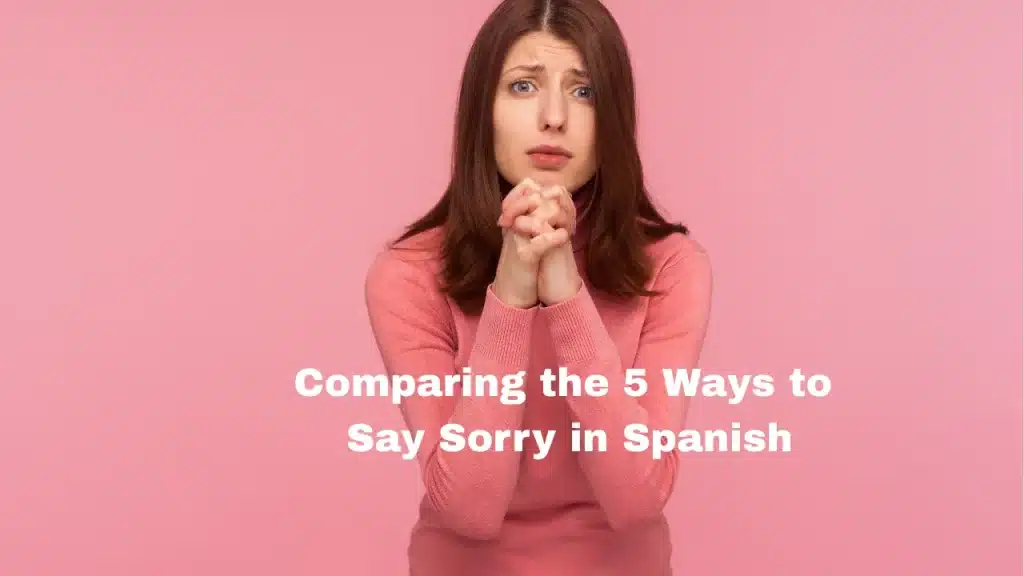Saying sorry in a new language shows respect and emotional intelligence. In this article, we will explore 5 ways to say sorry in Spanish. These expressions are not just translations but culturally important phrases used in real-life situations. Learning how to use them properly can help you improve your Spanish and build better communication.
Read more about: 20 other ways to say happy valentine’s day
Understanding the Importance of Apologizing in Spanish
When speaking Spanish, it’s not just what you say but how you say it. People value sincerity, tone, and the right choice of words. That’s why knowing 5 ways to say sorry in Spanish helps you respond in different contexts—whether you’re late, interrupting, or admitting a mistake. Using the correct form of apology is a sign of respect and maturity.
5 Ways to Say Sorry in Spanish
- Lo Siento
- Perdón
- Disculpa or Disculpe
- Mil Disculpas
- Me Equivoqué
1. Lo Siento – The Most Common Apology
Lo siento is the most universal way to express sorrow. It literally means “I feel it,” which shows empathy toward someone else’s feelings. You can use “lo siento” when you want to express regret, like after hurting someone emotionally or physically.
For example, if you accidentally step on someone’s foot, say “Lo siento” right away. It’s also appropriate after hearing bad news when you want to express sympathy.
2. Perdón – Asking for Forgiveness
Perdón is a strong yet short word that means “forgiveness” or “pardon.” It works well when you interrupt someone, bump into a stranger, or make a minor mistake. Saying “perdón” is a quick and polite way to get someone’s attention or apologize.
If you’re walking through a crowded street and need to pass, a simple “Perdón” does the job. It’s direct but still polite.
3. Disculpa or Disculpe – Casual and Formal Apology
The words disculpa and disculpe both mean “excuse me,” but they vary based on formality. Disculpa is for informal situations with friends or people your age. Disculpe is formal and used for elders or strangers.
You might say “Disculpa por llegar tarde” (Sorry for being late) when talking to a friend. For a boss or teacher, you’d say “Disculpe, no fue mi intención.” These phrases reflect the tone and respect expected in Spanish-speaking cultures.
4. Mil Disculpas – A Deeper Level of Apology
When a simple “sorry” doesn’t feel enough, you can say mil disculpas—which means “a thousand apologies.” This phrase shows that you truly regret what happened and want to make amends.
People use “mil disculpas” when they are really sorry or feel embarrassed by their mistake. It’s more dramatic and emotional, showing sincerity. If you’ve forgotten someone’s birthday or caused serious inconvenience, “Mil disculpas” expresses deeper regret.
5. Me Equivoqué – Admitting a Mistake
The phrase me equivoqué translates to “I made a mistake.” This apology is used when you take responsibility for an action or decision. It’s useful in personal and professional settings and shows accountability.
Imagine you gave someone the wrong direction or forgot to do a task at work. Saying “Me equivoqué, lo corregiré de inmediato” (I made a mistake, I’ll fix it immediately) is mature and respectful.
Comparing the 5 Ways to Say Sorry in Spanish

| Spanish Phrase | English Meaning | Usage Example | Formality Level |
|---|---|---|---|
| Lo siento | I’m sorry | Lo siento por lo que pasó (I’m sorry for what happened) | Neutral |
| Perdón | Pardon/Forgive me | Perdón, fue sin querer (Sorry, it was unintentional) | Neutral |
| Disculpa / Disculpe | Excuse me / Sorry | Disculpe, no quise interrumpir (Sorry to interrupt) | Formal/Informal |
| Mil disculpas | A thousand apologies | Mil disculpas por el error (A thousand apologies) | Emotional/Formal |
| Me equivoqué | I made a mistake | Me equivoqué y lo admito (I was wrong and I admit it) | Honest/Neutral |
Cultural Sensitivity and Spanish Apologies
Knowing 5 ways to say sorry in Spanish is more than memorizing words—it’s about understanding emotion and timing. In many Spanish-speaking cultures, people appreciate heartfelt and respectful apologies. Using the right expression at the right time shows that you are thoughtful and polite.
It is also common to see people combine phrases for stronger effect. For example, “Lo siento mucho, de verdad me equivoqué” blends empathy and accountability.
Read more about: 20 other ways to say have a great weekend
When to Use Which Apology Phrase
Every apology phrase in Spanish serves a different purpose. Here’s how to know which one to use:
- Lo siento – Best for emotional apologies or sympathy.
- Perdón – Great for light accidents or interruptions.
- Disculpa/Disculpe – Suitable for minor issues and to be polite.
- Mil disculpas – Use when you feel deeply sorry or want to show emotion.
- Me equivoqué – Ideal when you want to own up to your mistake directly.
When to Use Each Spanish Apology
| Situation | Best Phrase |
|---|---|
| You step on someone’s foot | Lo siento |
| You interrupt a conversation | Disculpe |
| You are late to a meeting | Disculpa |
| You forgot a birthday | Mil disculpas |
| You sent an email to the wrong person | Me equivoqué |
Practice Makes Perfect in Real Conversations

To master these 5 ways to say sorry in Spanish, try using them in your daily conversations. Whether you’re chatting with a friend or messaging a colleague, these phrases fit many situations. Practicing aloud or writing them in examples helps you feel more confident when apologizing in Spanish.
The more you practice, the easier it becomes to express your emotions properly in Spanish. These small phrases carry big meanings when used with sincerity and understanding.
Read more about: 20 Other Ways to Say Happy Birthday in Advance
Conclusion
Learning the 5 ways to say sorry in Spanish helps you become a more respectful and culturally aware speaker. Each phrase—Lo siento, Perdón, Disculpa, Mil disculpas, and Me equivoqué—adds a layer of meaning to your conversations. Whether it’s a casual setting or a formal situation, using the right apology shows empathy and character. So next time you need to say sorry, remember these powerful expressions and use them with confidence.







